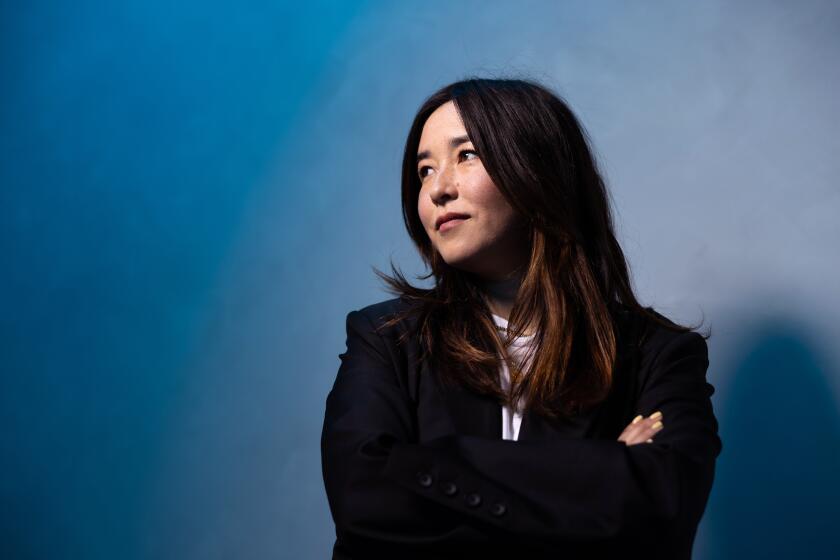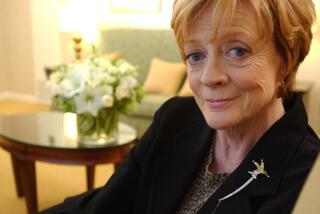
“Do you want to kiss me? Not as dogs this time, just actually...” That’s Maya Erskine as Jane, who’s ready to renege on the “no romance” agreement made earlier with her faux-husband, John (Donald Glover), in “Mr. & Mrs. Smith.” But that was before the semi-amateur spies accidentally killed John Turturro’s billionaire character after he subjected them to his dog fornication fetish. Now, Jane and John forget their platonic vow and go for it, silhouetted against a candy-colored TV cartoon blaring zanily in the background.
It’s an inventive piece of staging from Hiro Murai, Emmy nominated for directing the pilot of Prime Video’s “Mr & Mrs. Smith.” (Murai also earned nominations as an executive producer of both “Smith” and “The Bear.”)
Speaking from his Silver Lake home, the USC-educated filmmaker, whose previous Glover collaborations include “Atlanta” and the Childish Gambino music video “This Is America,” talks about mastering the sad comedy/funny drama TV space to build a millennial-friendly take on what it means to be a spy in 2024. (He also explains what happens when a spy cat goes rogue.)
Donald Glover, Brian Tyree Henry and Hiro Murai break down how the FX series comes together.
“Mr. & Mrs. Smith,” officially a drama, has a lot of comedy. Do you like to mix and match when it comes to tone?
What I think is most interesting in a TV show is the in-between-ness of genres, so I’m very mindful of subverting expectations in anything we make. For “Mr. & Mrs. Smith,” the expectation going in is probably the Brad Pitt-Angelina Jolie high-octane popcorn movie. We tried to figure out, “How do we take what is inherently unrelatable about the spy genre and make it, you know, something you can hold?” Me, Fran [co-creator Francesca Sloane], Donald, Maya — we’re all kind of the same age, so we have a similar point of view on millennial adulthood and what being coupled up feels like at our age. In that way, “Mr. & Mrs. Smith” became a study of modern intimacy.
Seeing the classic spy genre as unrelatable because …
Because I think the spy genre is a sort of wish fulfillment about highly capable people who are equipped with gadgets and conduct themselves effortlessly. My experience of adulthood is not that. It’s a very effortful affair. [Laughing.] The core crux of our show became, “OK, you’re cosplaying as capable adults, but really you’re insecure and pretending to be something you’re not.”

How did you configure the visual language for “Mr. & Mrs. Smith”?
It’s a story about two lonely strangers forced into a marriage and occupying this big brownstone mansion, so the image that immediately came to us was two cats trying to sniff each other out in the same house. I naturally gravitated to [framing] John and Jane as small figures inside this opulent, cold space where the only place they can find human connection is with each other. Especially in the pilot, it’s a subtle game of push and pull where our characters are trying to get closer while not revealing themselves too much.
“Mr. & Mrs. Smith” includes a mission for each episode, but there are no real villains, no visible boss, no higher cause. Why was that kind of plot left out?
Much of the fun, for me, was to show how little John and Jane know about their job. Who’s ordering them around? Why? Fran and I talked early on about this Japanese show we like called “Terrace House,” about people moving into an empty house. We realized the whole conceit for “Mr. & Mrs. Smith” almost feels like a reality show. John and Jane have been randomly selected; they have no idea why they’re doing what they’re being asked to do, they’re probably being observed — there’s something scary and absurd about their living situation, so it just felt right to lean into the paranoia and limit our characters’ understanding of what’s happening to them.
Playing a spy forced the actor to get in shape. It had another impact as well. ‘It opened a part of my brain that is helpful in life right now,’ the actor says.
And then there’s the cat, “Max,” who shows up in the first episode and almost makes it to the end. Were you working with a well-trained cat-actor?
[laughing]. It’s never easy because animals don’t know they’re in a TV show. One time the cat escaped and ran underneath our set, so we were basically shut down for an hour while the animal wrangler crawled around trying to find him. [Guest stars] Paul Dano and John Turturro were both there that day, so we all just sat in the living room set listening to scratching [sounds] underneath.
How did it feel when you wrapped production on Season 1?
It was gratifying because, initially, we didn’t really know what the outcome was going to look like. We knew the people involved were interesting and we knew the spy genre wants to be snappy, where they say all the right things at the right time. Part of the prompt for us was to find two bumbling “normies” in this world and show a clumsy reality to the way John and Jane interact, which seems more meander-y and less presentational. To see this elaborate experiment play out with collaborators you trust — I feel very fortunate.
More to Read
From the Oscars to the Emmys.
Get the Envelope newsletter for exclusive awards season coverage, behind-the-scenes stories from the Envelope podcast and columnist Glenn Whipp’s must-read analysis.
You may occasionally receive promotional content from the Los Angeles Times.












